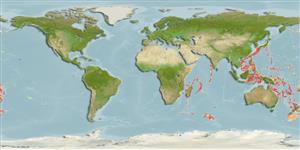Teleostei (teleosts) >
Perciformes/Scorpaenoidei (Scorpionfishes) >
Peristediidae (Armored searobins or armored gurnards)
Etymology: Paraheminodus: Greek, para = the side of + Greek, hemi = the half + Gree, odous = teeth (Ref. 45335).
More on author: Günther.
Environment: milieu / climate zone / depth range / distribution range
Ecology
Marine; bathydemersal; depth range 360 - 710 m (Ref. 27468). Deep-water
Indo-West Pacific: off Horn of Africa, Maldives, Indonesia, New Caledonia, and southern Japan.
Size / Weight / Age
Maturity: Lm ? range ? - ? cm
Max length : 26.5 cm SL male/unsexed; (Ref. 27468)
Short description
Identification keys | Morphology | Morphometrics
Dorsal spines (total): 7; Dorsal soft rays (total): 20 - 22; Anal spines: 0; Anal soft rays: 20 - 21. Head large, broadly expanded laterally; rostral process long and flattened; filamentous barbel long, extending to dorsal-fin origin. Reddish, edge of dorsal fin black (Ref. 9771).
A deepwater species (Ref. 9771). Bony scutes reduce commercial value (Ref. 9771).
Life cycle and mating behavior
Maturities | Reproduction | Spawnings | Egg(s) | Fecundities | Larvae
Richards, W.J., 1999. Triglidae. Gurnards, sea robins, armored gurnards, and armored sea robins. p. 2359-2363. In K.E. Carpenter and V.H. Niem (eds.) FAO species identification guide for fishery purposes. The living marine resources of the WCP. Vol. 4. Bony fishes part 2 (Mugilidae to Carangidae). FAO, Rome. (Ref. 9771)
IUCN Red List Status (Ref. 130435)
Threat to humans
Harmless
Human uses
Fisheries: of no interest
Tools
Special reports
Download XML
Internet sources
Estimates based on models
Preferred temperature (Ref.
123201): 2.3 - 12.8, mean 8.8 °C (based on 239 cells).
Phylogenetic diversity index (Ref.
82804): PD
50 = 0.5625 [Uniqueness, from 0.5 = low to 2.0 = high].
Bayesian length-weight: a=0.00646 (0.00304 - 0.01372), b=3.08 (2.90 - 3.26), in cm total length, based on LWR estimates for this (Sub)family-body shape (Ref.
93245).
Trophic level (Ref.
69278): 3.5 ±0.3 se; based on size and trophs of closest relatives
Resilience (Ref.
120179): Medium, minimum population doubling time 1.4 - 4.4 years (Preliminary K or Fecundity.).
Fishing Vulnerability (Ref.
59153): Low vulnerability (22 of 100).
